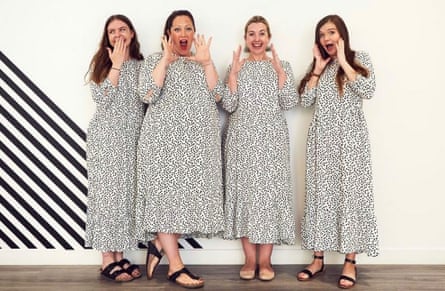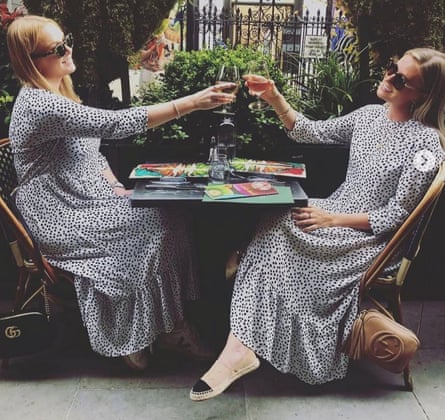The dress is very good friends with leather jackets, red lipstick, Birkenstocks, Veja trainers, totes and cross-body shoulder bags. It does not have time for the performance of modern femininity – an embarrassment of Lycra, neon and scratchy lace. It can be worn when the weather is intolerably warm and your day stretches ahead of you – work, drinks, dinner – and it won’t chafe or itch. The dress is on your side.
You will have met the dress by now, even if you don’t remember it. Perhaps it was on a train platform, or at a summer barbecue. This £39.99 Zara polka-dot midi dress has become this year’s unexpected fashion success, worn by women across the country and feverishly discussed online.
It has been the subject of glowing profiles (“The US$50 dress that conquered Britain”) and an inevitable backlash (“Summer’s hottest Zara dress is a US$70 sack.”) It is beloved by influencers and celebrities – the fashion blogger Susie Verrill wore the dress in March, and the broadcaster Victoria Derbyshire is also a proud owner, wearing it on her BBC show in July. “It’s a charming dress. Polka dots are delightful and the flowing skirt suits any size or height,” Derbyshire tells me. The dress “covers my cleavage and looks good with heels or white trainers,” she says.
There is even an Instagram account, Hot 4 the Spot, dedicated to sharing images of the dress – as it is uniformly referred to by its fans – in the wild. But how did a simple Zara frock come to represent Spain’s most significant cultural invasion since the Armada set sail for British waters?
Caz Wren, 47, a London-based makeup artist, is arguably the reason the dress went viral. Wren bought it in February. “It was perfect for me – it covers all bases.” She liked it because it wasn’t too fitted across the bust – as Wren has a large chest, dresses look unflattering if they have high waistlines.

On 19 April, Wren was working at a studio in north London while wearing the dress. She had styled it with trainers and a blazer, and was applying makeup to a model when she saw the art director Clementine O’Hara walking towards her. In the same dress. “She had a blazer and black boots on, and I’d actually tried on black boots that morning.”
Also in the room was their mutual friend, 28-year-old stylist Faye Oakenfull. “I put it on my Instagram as a funny awkward fashion moment,” Oakenfull remembers. “People started messaging me. It escalated from there.” Over the next few weeks, Oakenfull documented sightings on her Instagram. “Everyone started getting really into it.” When Oakenfull went on holiday, she said: “I’m not doing any dress content for a week.” By then, her followers were hungry for polka-dot content and, on her return in May, Oakenfull set up Hot 4 the Spot, describing it as a “safe space for the dress”.
There have been other viral fashion sensations in recent years: last summer’s M&S jumpsuit, or the Réalisation Par leopard-print skirt with an Instagram fan account. But the Zara dress is a different beast. This is not a cult item being worn by a narrow cross-section of women of similar ages and economic backgrounds. It has transcended its initial cool-girl early adopters to become a sartorial choice for women of all shapes, sizes and ages. It is no longer the preserve of slim, middle-class city-dwelling women who work in offices and do pilates. The dress is worn at village fetes, suburban barbecues and on school runs. It has become the everywoman dress.
Why is it so popular with such a diverse range of women? “It’s a readymade outfit,” says Neelam Hundal, a 31-year old solicitor from London, who bought the dress in April. “It will go with anything. It can be casual – I’ve worn it on the beach – but I can also wear it to the office.” Plus, it suits all body types.
“It’s really unusual to find in our modern times an item that suits so many people,” says Nicola Melody, a 37-year-old senior manager from Leeds. “Usually, when something is popular it’s got really thin straps, so you can’t wear a bra, or it’s too fitted so doesn’t suit anyone with a hint of stomach. But this dress suits everyone.”

The fact that the dress is not revealing is a major selling point. “I’m Muslim and I always want to wear something quite modest in terms of the length and covering my arms,” says Sadia Siddiqui, a 45-year-old strategist from east London. “It’s modest, but also stylish.”
Sharmaine Foster, a 40-year-old housekeeper from Barton-le-Clay in Bedfordshire, feels it is age-appropriate, but also on trend. “Everything in shops tends to be short or cropped, and I’m a bit past that now.”
What makes such a demure dress summer’s hottest fashion trend? “You couldn’t be more covered up,” says Pamela Church Gibson, a fashion historian, adding that the dress is a form of sartorial protest. “It’s a reaction against very revealing clothes.” She references Kim Kardashian’s appearance at the Met Ball in a corseted Thierry Mugler dress, and the Love Island contestants in their spray-on Lycra. “The fact it’s so comfortable is very important. It moves past your body and works with it. It doesn’t attempt to rein it in or enclose it. It’s a great relief to put on a dress like that. It gives you that feeling of being completely comfortable in your own skin.”
I think of Church Gibson’s words as I unfold the dress from its packaging. Despite previously selling out, it is still available online in some sizes. Zara will not say how many dresses have been sold. By now, I have heard so much about it that it feels like meeting an old friend. Slipping on the dress, I understand immediately what the fuss is about. It is more voluminous than I thought – and no one warned me how hard it is to do up the button at the back of the neck. But it feels like wearing a nightie, which is to say wonderful. Out for dinner on Saturday night, I gorge myself on pillowy pide, hummus and kebab and experience the joy of my stomach expanding gently like a self-inflating airbed under a polka-dot canvas, invisible to anyone but me.
In a society that aggressively polices the female body, the dress feels forgiving. It will drape kindly over wobbly arms and can accommodate a large meal. It also washes well – and air dries without creasing, so it is ideal for women who don’t have the time or inclination for ironing.
Perhaps this is why an unlikely sisterhood has sprung up around the dress. “It has started a weird club that people want to be a part of,” Oakenfull explains. “It’s this massive fingers-up to the idea that women should pit ourselves against each other and decide who wore it best. It’s about embracing the fact that we’re all wearing the same thing and enjoying it.”
Wearing the dress on the street is like being part of a secret coterie. “You get smiles, mainly from other women,” says Melody.
It is a brave – or foolhardy – woman who wears the Zara dress to a social occasion, given how likely it is that someone else will be wearing it. Either that, or she wants the thrill of walking into a room, knowing that the dress may also be there. “Part of my love of the dress is the idea that I shouldn’t wear it because so many other people have it,” Melody says. “But that just makes me want to wear it more.”

Still, things can get awkward. When 24-year-old Jessica Eve Nilsson, a business manager from Surrey, met a friend for lunch in July, she couldn’t figure out why diners were laughing as she arrived. The reason was simple: she and her friend were wearing the dress.
“Everyone was looking at us and doing double-takes,” Nilsson says. “It was one of the weirdest experiences.” As they were sitting at an outdoor table, they were prime photo fodder – when Nilsson sent a photo to Hot 4 the Spot, Oakenfull replied saying she had already received one, taken without their knowledge. After lunch, they went for drinks – and bumped into about 10 other women, also wearing the dress. While Nilsson sees the funny side, it is not an experience she wants to repeat – she has not worn the dress since.
The online community around the dress is especially heartwarming, given how negative social media is for many women. There is no toxicity, only women swapping tips on how to dye the dress different colours, or sharing images of themselves beaming in identical outfits. The day after we speak, Oakenfull uploads a picture of 11 women wearing the dress in a giant human chain at the Wilderness festival.

The dress is also remarkable because it is one of the only “It” dresses to have a mass-market price point. “If you think about the Roland Mouret dress,” says Church Gibson, referencing the £1,000 Galaxy design that was ubiquitous in the media in 2005, “that was very expensive.”
A decade on, the commotion around a £40 Zara frock is a reflection of our straitened financial times. “I haven’t got any money, I’m worrying about Brexit,” summarises Church Gibson. She says the last time this prairie-inspired silhouette was popular was in the 1970s, when Laura Ashley dressed a generation during a decade of economic crisis.
The dress’s popularity also shows the waning influence of traditional industry gatekeepers. The Galaxy dress, modelled by celebrities such as Rachel Weisz and Cameron Diaz, was celebrated on the pages of Vogue, before being ripped off by the high street. Now we are introduced to the Zara dress through social media. “It shows more than anything the power of Instagram,” says Church Gibson. “There is this alternative system of fashion media, that is not dependent on looking at magazines.”

Of course, fast fashion tends to have a human cost: low wages and poor conditions for the workers who produce it. Zara’s owner, Inditex, does not publish the names of the factories it uses, so it is hard to find out what life is like for the people who make the dress. When asked for this article how the dress is made, Zara did not wish to comment. Inditex’s 2018 annual report states that they “firmly believe that our model only works if it is sustainable ... [we] have placed the workers in our supply chain at the centre of systems of control in order to foster initiatives that promote social progress.”
A dress can mean many things to many people. This is a story of how we went mad for a cheap frock during a summer of great political uncertainty, how we started hugging strangers on the street while Britain baked and it began to feel as if the country was tipping headlong over a precipice.
“We are in very dark times at the moment,” says Melody. “We have a prime minister we didn’t vote for, the prospect of a no-deal Brexit in October, Trump in America. There’s a lot of awful stuff in the world at the moment and not a lot of joy. I think people do latch on to the thing that brings them joy. The dress did that. It’s fun, accessible. It’s got us talking to each other, strangers coming up to people on the street. It’s allowed people to connect with each other.” Melody pauses: “Maybe that’s a bit profound for a piece of clothing.”
It is a bit far-fetched, I think, until I am walking down the street on Sunday evening and see yet another woman smiling at me. Never underestimate the power of the dress.

Comments (…)
Sign in or create your Guardian account to join the discussion